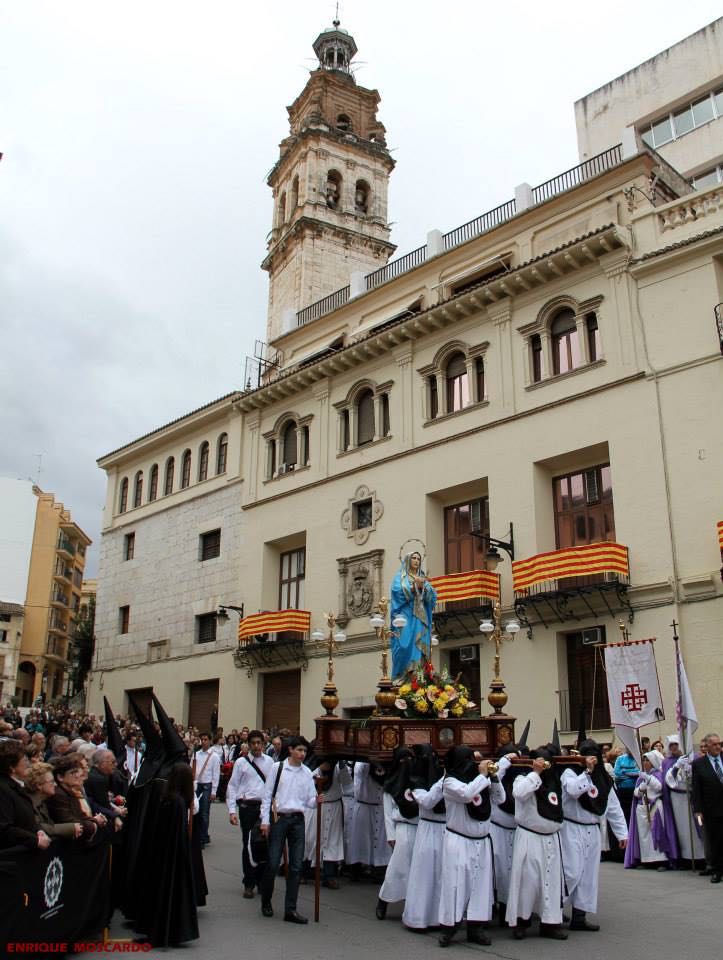Lent, Holy Week, and Easter, are intimately linked, as Lent precedes Holy Week, which precedes Easter. Lent and Holy Week in Spain are a time of public devotion, as all cities and towns hold processions and other prayerful and sorrowful celebrations where the church images will take on the streets on solemn and impassioned parades.
Lent, called Cuaresma in Spanish, is the fourty day period that precedes Easter (the word Cuaresma comes from the Latin quadragesima, fortieth). It starts on Ash Wednesday, the day after Tuesday of Carnival, and ends on Holy Thursday, comprising six Sundays including Palm Sunday, which is the last Sunday before Easter. Cuaresma is, in the Catholic tradition (so embedded in Spain’s history), a period of meditation and repentance from faults committed, a season for acts of mercy and for fasting, including abstinence from eating meat and meat products on Fridays. This limitation in quantity and type of food during Cuaresma, Lent, has led to a category of dishes in the Spanish gastronomy at this time of year, developed over the centuries, that draws on the abundance and richness of Spain’s fish, as well as on eggs, vegetables and pulses, or legumes. There’s also a category of sweets and baked goods that, although made year round nowadays, are typical of this calendar period.

Salt Cod at Mercado Central de Valencia
Among the fish eaten in Cuaresma, the indisputable star is cod. There’s a whole industry that involves the salting of cod, that is one of Spain’s more popular food preserving industries. As a young girl, I remember going with my mom to “los salazones”, a sort of convenience store that sold a bit of everything, but mostly preserves, and particularly the salt cod that hung like clothes drying on a clothesline, above the counter and sometimes running the perimeter of the store.
There are many cod dishes associated with Lent, Cuaresma, including bacalao en salsa verde, cod in green sauce, or bacalao al pil pil, cod pil pil style (a sauce patiently made based on the jelly released from the cod skin), or bacalao con pisto, pisto being a sauce equivalent and similar to ratatouille.

Buñuelos de Viento
The sweets and baked goods eaten during Lent and Easter vary by region, although some are made all over Spain, like torrijas, sugary sweet bread, or buñuelos de Pascua or buñuelos de viento, literally translated as fritters of Easter, or fritters of the wind. Mona de Pascua, a sweet round bread sometimes decorated with candied fruit and that sometimes includes a hard boiled egg placed at its center is typical

Mona de Pascua
of the Levante region. They will not be eaten until Easter Sunday, hence their name, monas de Pascua. Hornazas, similar to monas but in the shape of a cross, are made in Toledo, while leche frita, “fried milk”, and tortas de aceite, olive oil thin crisp tortas, are mostly eaten in Andalusia. In Cataluña, monas de Pascua refer to chocolate mini-sculptures typical of this season.
Holy Week Traditions
The last week of Lent coincides with Holy Week, which is considered the most important calendar week in the Catholic Church. It starts on Palm Sunday, when we celebrate Jesus’ entrance into the city of Jerusalem with the occasion of the feast of Passover. Every town and city in Spain holds a Procesión de Domingo de Ramos, a Palms Sunday Procession, where the believers will carry palms, some very intricately woven, to accompany a float holding a statue representing Jesus’ entrance in Jerusalem. I remember, as a young girl, my grandma Maravillas would buy the palms for all eleven grandchildren, the boys’ were a palm tree branch that was usually taller than them, and the girls’ a fancy, woven one.

Good Friday procession in Onteniente

Christ of the Palm, Onteniente

Brotherhood of the Holy Sepulcre, Good Friday procession in Onteniente
The Triduum, the three days that preceed Easter Sunday, namely Holy Thursday, Good Friday and Glory Saturday, are three intense days of religious processions and representations of Jesus’ way to the cross, including his Last Supper on Thursday and his Way to Calvary on Friday. Brotherhoods called cofradías prepare for these processions year round. The cofrades, the brothers, will wear special outfits, many times covering their faces and heads with capirotes, conical shaped hats, and will carry the tons-heavy floats with the sculptures of different scenes of Jesus’ passion. Of particular interest, for their emotion and magnitude, are the Holy Week processions in Andalusia, in Orihuela and in Zamora, but basically every city and town has its own. My own city of Onteniente has nine different brotherhoods, whose nazarenos, nazareans, carry the images of the Virgen Dolorosa, Sorrowful Mary, the Cristo de la Expiración, the Christ of the Expiration, and the Santo Sepulcro, the Holy Sepulcre, among others, throughout the streets of Onteniente. The gremios, labor unions, are the origin of each of these brotherhoods, including the carpenters, the farmers, the land laborers and the vintners. The special outfits that the nazarenos wear, composed of a habit, a cape and a capirote, sometimes with a veil that covers the nazareno’s face, have their origin in the Middle Ages, and simbolize the person’s repentance from his or her faults.

Our Lady of Sorrows, Good Friday procession in Onteniente



Brotherhood of the Holy Sepulcre, Good Friday procession, Onteniente

El Encuentro Doloroso, Jesus meets his Mother, Good Friday Procession, Onteniente

Brotherhood of the Holy Face, Onteniente
Spain, while it has become much more secular, still keeps the religious festivals, including the Holy Week Processions, an integral part of its traditions.
Special thanks to my friend Enrique Moscardó, whose photos of Holy Week in Onteniente illustrate this page. For more from Enrique, click here. For more on Barrio de La Vila in Onteniente, click here.

Our Lady of Sorrows, processing in City Hall Square, Onteniente

